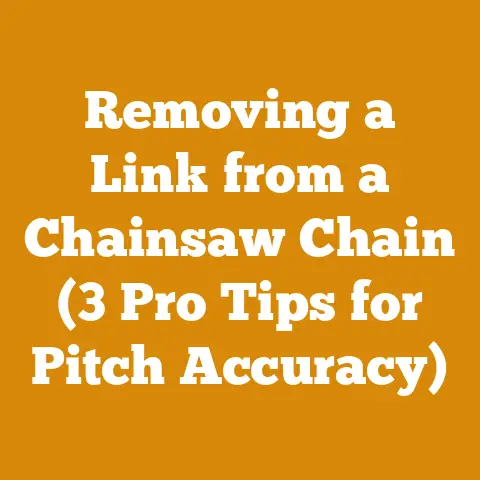What Kills Tree Roots Fast? (5 Proven Arborist Hacks)
Have you ever stared at a stubborn tree stump, its roots tenaciously gripping the earth, and wondered how to reclaim your yard without waiting an eternity?
I have.
Many times.
Over the years, I’ve battled my fair share of unwanted trees, from volunteer saplings popping up in my garden beds to larger specimens threatening the foundation of my shed.
Through trial and error, countless hours of research, and advice gleaned from seasoned arborists, I’ve developed a repertoire of techniques for dealing with unwanted tree roots.
In this article, I will share five proven arborist hacks to effectively eliminate tree roots quickly.
These are methods I’ve personally used, adapted, and refined over years of hands-on experience.
I will delve into the science behind each technique, explaining why they work and how to implement them safely and effectively.
I’ll also share some personal anecdotes and lessons learned along the way.
Understanding the Enemy: Tree Root Anatomy and Physiology
Before diving into the methods, it’s crucial to understand what we’re up against.
Tree roots aren’t just underground anchors; they’re complex living systems responsible for nutrient and water uptake, storage, and even communication with other trees.
The Root System: A Network of Life
A tree’s root system is typically a mirror image of its crown, spreading outwards and downwards to maximize its access to resources.
The main structural roots, often thick and woody, provide stability.
Radiating from these are smaller, branching roots, and finally, the fine, hair-like rootlets that do the actual work of absorption.
- Taproot: Some trees, like oaks and hickories, have a dominant taproot that grows straight down, providing deep anchorage.
- Lateral Roots: Most trees rely on a network of lateral roots that spread horizontally, often close to the surface.
- Root Hairs: These tiny extensions dramatically increase the surface area for water and nutrient absorption.
The Role of the Cambium Layer
The cambium layer is a thin layer of cells located beneath the bark.
It’s responsible for producing new xylem (wood) and phloem (inner bark), which are essential for the tree’s growth and survival.
Disrupting the cambium layer effectively cuts off the tree’s supply line, leading to its demise.
Photosynthesis and Translocation
Trees rely on photosynthesis to produce energy.
The sugars created in the leaves are transported down to the roots through the phloem.
Conversely, water and nutrients absorbed by the roots are transported upwards to the leaves through the xylem.
Understanding this flow is crucial when choosing a method to kill tree roots.
Wood Properties and Root Decay
The rate at which tree roots decay depends on several factors, including the species of tree, the moisture content of the soil, and the presence of decay-causing organisms.
Hardwoods, like oak and maple, generally take longer to decompose than softwoods, like pine and fir.
- Hardwood vs.
Softwood Decay Rates: Hardwoods, with their denser cell structure, can resist decay for several years, while softwood roots might decompose within a year or two. - Moisture Content and Decay: High moisture content encourages fungal growth, accelerating the decay process.
- Soil Organisms: Bacteria, fungi, and insects all play a role in breaking down dead wood.
Arborist Hack #1: The Herbicide Application Technique
This is often the first line of defense for arborists dealing with unwanted trees.
Herbicide application involves using chemical compounds to disrupt the tree’s physiological processes, ultimately leading to its death.
However, it’s crucial to use herbicides responsibly and safely, following all label instructions and taking precautions to protect non-target plants and the environment.
Choosing the Right Herbicide
Not all herbicides are created equal.
When selecting an herbicide for tree root control, consider the following factors:
- Active Ingredient: Glyphosate and triclopyr are two common active ingredients effective against a wide range of tree species.
Glyphosate is a non-selective herbicide, meaning it will kill any plant it comes into contact with, while triclopyr is more selective, targeting woody plants. - Formulation: Herbicides are available in various formulations, including liquids, granules, and gels.
Liquid formulations are typically used for foliar sprays or cut-stump treatments, while granular formulations are used for soil application.
Gels are ideal for precise application to cut surfaces. - Tree Species: Some herbicides are more effective against certain tree species than others.
Consult the product label or your local extension office for recommendations.
I remember one time I was trying to get rid of a particularly stubborn Ailanthus tree (Tree of Heaven) that kept sending up suckers all over my yard.
I tried glyphosate, but it only seemed to stunt the growth temporarily.
Finally, I switched to triclopyr, and it did the trick.
The key was to use a concentrated formulation and apply it directly to the freshly cut stump.
Application Methods
There are several ways to apply herbicides to kill tree roots:
- Foliar Spray: This involves spraying the herbicide directly onto the leaves of the tree.
It’s most effective for small trees and saplings.
However, it’s important to avoid spraying non-target plants. - Cut-Stump Treatment: This involves cutting the tree down and applying the herbicide to the freshly cut stump.
This method is effective for larger trees and helps prevent regrowth. - Basal Bark Treatment: This involves applying the herbicide to the lower portion of the tree trunk.
The herbicide is absorbed through the bark and translocated to the roots. - Soil Application: This involves applying granular herbicide to the soil around the base of the tree.
The herbicide is absorbed by the roots.
This method is generally less effective than other methods and can potentially harm non-target plants.
Step-by-Step Guide to Cut-Stump Treatment
This is the method I’ve found most effective for killing tree roots quickly and preventing regrowth:
- Cut the Tree Down: Use a chainsaw or handsaw to cut the tree down as close to the ground as possible.
- Apply Herbicide Immediately: Within minutes of cutting the tree, apply a concentrated herbicide solution to the freshly cut stump.
Use a paintbrush or sprayer to saturate the outer layer of the stump, including the cambium layer. - Monitor for Regrowth: Check the stump regularly for signs of regrowth.
If you see any new shoots emerging, reapply the herbicide. - Consider Stump Removal: Once the roots are dead, you can either leave the stump to decompose naturally or remove it using a stump grinder or other method.
Safety Precautions
- Read the Label: Always read and follow all label instructions carefully.
- Wear Protective Gear: Wear gloves, eye protection, and a long-sleeved shirt when handling herbicides.
- Avoid Spraying on Windy Days: To prevent drift, avoid spraying herbicides on windy days.
- Protect Non-Target Plants: Take precautions to protect non-target plants from herbicide exposure.
- Store Herbicides Safely: Store herbicides in a secure location out of reach of children and pets.
Data and Statistics
- A study by the University of California found that cut-stump treatment with glyphosate was 90-100% effective in preventing regrowth of eucalyptus trees.
- The cost of herbicide treatment can range from \$5 to \$50 per tree, depending on the size of the tree and the type of herbicide used.
Arborist Hack #2: The Salt Method
Using salt to kill tree roots is an age-old technique that relies on the principle of osmosis.
Salt draws water out of the roots, dehydrating them and eventually leading to their death.
While effective, it’s important to use this method cautiously, as excessive salt can harm surrounding soil and vegetation.
How Salt Works
Salt (sodium chloride) is a desiccant, meaning it absorbs moisture.
When applied to the soil around tree roots, it creates a hypertonic environment, where the concentration of salt is higher outside the roots than inside.
This causes water to move out of the roots through osmosis, leading to dehydration and cell death.
Types of Salt to Use
- Rock Salt: This is the most commonly used type of salt for killing tree roots.
It’s inexpensive and readily available. - Epsom Salt: While technically not a salt, Epsom salt (magnesium sulfate) can also be used to dehydrate tree roots.
However, it’s generally less effective than rock salt. - Table Salt: Table salt can be used, but it’s more expensive than rock salt and doesn’t offer any additional benefits.
Application Techniques
- Direct Application to the Stump: Drill holes into the stump and fill them with salt.
This method is effective for preventing regrowth after cutting down a tree. - Soil Application: Dig a trench around the base of the tree and fill it with salt.
This method is effective for killing the entire tree. - Saltwater Solution: Dissolve salt in water and pour the solution around the base of the tree.
This method is less likely to harm surrounding vegetation than direct application.
Step-by-Step Guide to the Salt Method
- Cut the Tree Down (Optional): If you want to kill the entire tree, skip this step.
If you only want to prevent regrowth after cutting down the tree, cut it down as close to the ground as possible. - Drill Holes into the Stump (Optional): If you cut the tree down, drill several holes into the stump, spacing them a few inches apart.
The holes should be several inches deep. - Apply Salt: Fill the holes with salt, or spread salt around the base of the tree.
- Water the Salt (Optional): Watering the salt will help it dissolve and penetrate the soil.
- Monitor for Results: It may take several weeks or months for the salt to kill the tree roots.
You’ll know the treatment is working when the leaves start to turn brown and the tree begins to die.
I once used the salt method to kill a small willow tree that was growing too close to my septic tank.
I drilled holes into the stump and filled them with rock salt.
It took a few months, but eventually, the tree died, and I was able to remove the stump.
Environmental Considerations
- Soil Salinity: Excessive salt can increase soil salinity, making it difficult for other plants to grow.
- Water Contamination: Salt can leach into groundwater, potentially contaminating drinking water supplies.
- Non-Target Plants: Salt can harm or kill non-target plants if it comes into contact with their roots.
Data and Statistics
- A study by the University of Nebraska found that salt application was effective in killing eastern red cedar trees, but it also significantly increased soil salinity.
- The cost of salt treatment is relatively low, typically ranging from \$1 to \$5 per tree.
Arborist Hack #3: The Copper Nail/Sulfate Method
The copper nail or copper sulfate method is another time-honored technique for killing tree roots.
Copper is toxic to trees, and when introduced into the root system, it can disrupt essential physiological processes, leading to the tree’s demise.
How Copper Works
Copper is a micronutrient essential for plant growth, but in high concentrations, it becomes toxic.
When copper is absorbed by tree roots, it interferes with enzyme activity, disrupts nutrient uptake, and inhibits photosynthesis.
Types of Copper to Use
- Copper Nails: These are readily available at hardware stores and are a convenient way to introduce copper into the tree.
- Copper Sulfate: This is a chemical compound containing copper that is often used as a fungicide and algaecide.
It’s available in powder or crystal form.
Application Techniques
- Nail Insertion: Drive copper nails into the base of the tree trunk, spacing them a few inches apart.
This method is most effective for smaller trees. - Copper Sulfate Solution: Dissolve copper sulfate in water and pour the solution around the base of the tree.
This method is more effective for larger trees. - Direct Application to the Stump: Drill holes into the stump and fill them with copper sulfate crystals.
This method is effective for preventing regrowth after cutting down a tree.
Step-by-Step Guide to the Copper Nail Method
- Choose Copper Nails: Select pure copper nails.
Avoid nails that are coated or made of other metals. - Drill Pilot Holes (Optional): Drilling pilot holes can make it easier to drive the nails into the tree trunk, especially for hardwoods.
- Drive in the Nails: Drive the copper nails into the base of the tree trunk, spacing them a few inches apart.
The nails should be driven in as deeply as possible. - Monitor for Results: It may take several weeks or months for the copper to kill the tree roots.
You’ll know the treatment is working when the leaves start to turn brown and the tree begins to die.
I once used the copper nail method to kill a small aspen tree that was growing too close to my house.
I drove copper nails into the base of the trunk, and within a few months, the tree was dead.
Environmental Considerations
- Soil Contamination: Copper can accumulate in the soil, potentially harming other plants.
- Water Contamination: Copper can leach into groundwater, potentially contaminating drinking water supplies.
- Non-Target Plants: Copper can harm or kill non-target plants if it comes into contact with their roots.
Data and Statistics
- A study by the University of Florida found that copper sulfate was effective in controlling root growth in sewers, but it also posed a risk to water quality.
- The cost of copper nail treatment is relatively low, typically ranging from \$2 to \$10 per tree.
Arborist Hack #4: The Boiling Water Method
The boiling water method is a simple and environmentally friendly way to kill tree roots.
It works by scalding the roots, disrupting their cellular structure and preventing them from absorbing water and nutrients.
How Boiling Water Works
Boiling water is a powerful tool for killing living tissue.
When poured onto tree roots, the high temperature denatures proteins and disrupts cell membranes, effectively killing the root tissue.
Application Techniques
- Direct Pouring: Pour boiling water directly onto the exposed roots of the tree.
This method is most effective for small trees and saplings. - Stump Treatment: After cutting down a tree, pour boiling water into the freshly cut stump to prevent regrowth.
- Root Trench: Dig a trench around the base of the tree and pour boiling water into the trench.
This method is more effective for larger trees.
Step-by-Step Guide to the Boiling Water Method
- Boil Water: Bring a large pot of water to a rolling boil.
- Expose Roots (Optional): If possible, expose the roots of the tree by digging around the base.
- Pour Boiling Water: Carefully pour the boiling water onto the exposed roots or into the stump.
- Repeat as Necessary: Repeat the treatment several times, especially for larger trees.
- Monitor for Results: It may take several weeks or months for the boiling water to kill the tree roots.
You’ll know the treatment is working when the leaves start to turn brown and the tree begins to die.
I once used the boiling water method to kill a patch of bamboo that was spreading aggressively in my garden.
I poured boiling water onto the new shoots, and it effectively stopped the spread.
Safety Precautions
- Burns: Boiling water can cause severe burns.
Wear protective clothing and use caution when handling boiling water. - Non-Target Plants: Boiling water can harm or kill non-target plants.
Avoid pouring boiling water onto desirable vegetation.
Environmental Considerations
- Soil Temperature: Boiling water can temporarily increase soil temperature, potentially harming beneficial soil organisms.
However, the effect is usually short-lived. - Erosion: Pouring large amounts of water onto the soil can cause erosion.
Data and Statistics
- A study by the University of California found that boiling water was effective in controlling weeds in vegetable gardens.
- The cost of boiling water treatment is very low, typically only the cost of the energy to heat the water.
Arborist Hack #5: Physical Removal
Sometimes, the most direct and effective way to get rid of tree roots is to simply remove them physically.
This can be a labor-intensive process, but it’s often the best option for large roots or when you want to avoid using chemicals.
Tools for Physical Removal
- Shovels: Shovels are essential for digging around the roots and loosening them from the soil.
- Axes and Hatchets: Axes and hatchets are useful for chopping through smaller roots.
- Root Saws: Root saws are designed specifically for cutting through tree roots.
They have long, flexible blades that can reach into tight spaces. - Pickaxes: Pickaxes are useful for breaking up hard soil and dislodging large roots.
- Stump Grinders: Stump grinders are powerful machines that can grind down tree stumps and roots.
They’re a good option for removing large stumps quickly. - Excavators: Excavators are heavy machines that can be used to dig up entire tree root systems.
They’re typically used for large-scale projects.
Step-by-Step Guide to Physical Root Removal
- Excavate Around the Roots: Use a shovel to dig around the roots you want to remove.
- Cut the Roots: Use an axe, hatchet, or root saw to cut through the roots.
- Remove the Roots: Pull the roots out of the ground.
You may need to use a pickaxe to loosen them. - Dispose of the Roots: Dispose of the roots properly.
You can compost them, burn them, or take them to a landfill. - Fill the Hole: Fill the hole with soil and compact it.
I once spent an entire weekend digging up the roots of a large oak tree that had been cut down.
It was hard work, but I was determined to remove the roots so I could build a patio in that spot.
I used a combination of shovels, axes, and a root saw, and eventually, I got the job done.
Safety Precautions
- Eye Protection: Wear safety glasses to protect your eyes from flying debris.
- Gloves: Wear gloves to protect your hands from blisters and cuts.
- Foot Protection: Wear sturdy boots to protect your feet from injury.
- Chainsaw Safety: If using a chainsaw, follow all safety precautions.
Data and Statistics
- The cost of physical root removal can range from \$50 to \$500 or more, depending on the size of the roots and the equipment used.
- The time it takes to remove tree roots can vary from a few hours to several days, depending on the size and complexity of the root system.
Choosing the Right Method: A Decision Guide
With five different methods at your disposal, how do you choose the right one for your situation?
Here’s a decision guide to help you make the best choice:
- Tree Size: For small trees and saplings, the foliar spray, boiling water, or copper nail methods may be sufficient.
For larger trees, the cut-stump treatment, salt method, or physical removal may be necessary. - Environmental Concerns: If you’re concerned about the environmental impact of herbicides or salt, the boiling water or physical removal methods may be better options.
- Proximity to Other Plants: If the tree is close to other plants you want to protect, use a method that allows for precise application, such as the cut-stump treatment or copper nail method.
- Time and Effort: Physical removal is the most labor-intensive method, while the herbicide and salt methods require less physical effort but may take longer to show results.
- Budget: The boiling water method is the most budget-friendly option, while physical removal with a stump grinder or excavator can be the most expensive.
Preventing Future Problems: Root Barriers and Tree Selection
Prevention is always better than cure.
To avoid future problems with unwanted tree roots, consider using root barriers when planting new trees and choose tree species that are less prone to invasive root systems.
Root Barriers
Root barriers are physical barriers that are installed in the ground to prevent tree roots from spreading into unwanted areas.
They’re typically made of plastic or metal and can be installed around trees, sidewalks, or other structures.
Tree Selection
When planting new trees, choose species that are less prone to invasive root systems.
Some trees, like willows and poplars, have aggressive root systems that can damage sidewalks, sewers, and other structures.
Other trees, like oaks and maples, have less aggressive root systems.
Conclusion
Dealing with unwanted tree roots can be a challenging task, but with the right knowledge and techniques, it’s definitely achievable.
I have shared five proven arborist hacks that can help you effectively eliminate tree roots quickly and safely.
Remember to consider the size of the tree, your environmental concerns, and your budget when choosing a method.
And always follow safety precautions when handling herbicides, boiling water, or power tools.
Whether you choose the targeted precision of herbicide application, the natural approach of boiling water, or the directness of physical removal, remember that patience and persistence are key.
It might take time to see the results you desire, but with dedication, you can reclaim your yard and prevent future root-related headaches.
Now, go forth and conquer those unwanted tree roots!
Your garden will thank you for it.






